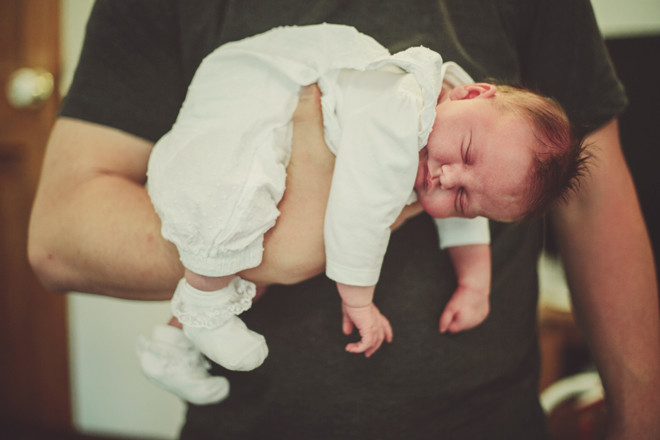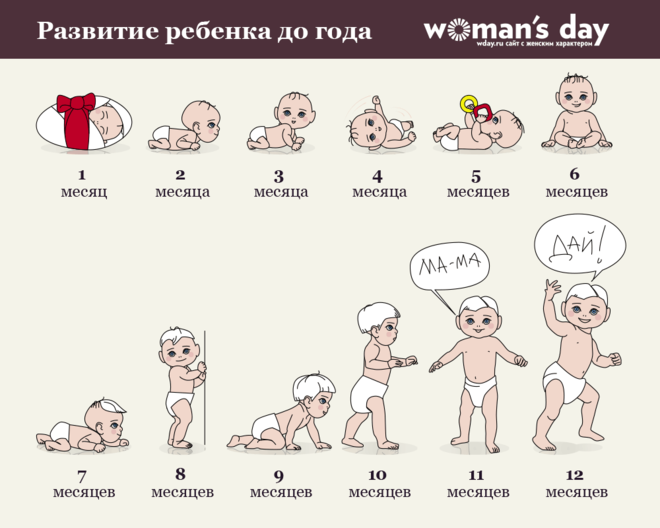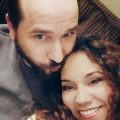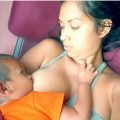First month: what should a baby be able to
So far the baby has no skills, butreflexes that are given to him from birth. They help him to eat, protect him from the dangers of this world and at the same time help him to explore it. We can highlight 10 of the most important of them.
 Photo: Getty4. Breath reflex. It protects the child during bathing: if the baby slips into the water, then he will stop breathing for a few seconds in order not to choke. As soon as you lift it out of the water, breathing will resume. This reflex disappears by three months. That is why the followers of the early swimming recommend teaching the kids to dive up to this period - because if you stimulate the breath-holding reflex, it will turn from congenital into acquired.5. Reflex crawling. If you put the baby on his tummy and put his hands to his soles, he will start pushing away from them, as if crawling away. The reflex will disappear by the third month of the infant's life.6. Reflex maintain the correct position of the head. It helps the baby to keep his head, legs and torso in a position that is as safe as possible for breathing. For example, if you put a newborn on his stomach, he will turn the head to the side to breathe. And if you put a diaper on a baby who is lying on his back, he will start turning his head and waving his arms, as if trying to throw it off. Grasp reflex. The kid squeezes the fists when objects, mother's fingers or hair fall into them. Later, with the help of this reflex, he will learn to grab toys, and then - to make more complex movements. The grasping reflex diminishes by three months, and disappears by six months.8. Reflex swordsman. If a newborn, lying on his back, turn his head to the side, after it the arm and leg will turn - and the baby adopts the so-called fencer pose. By three or four months, the reflex disappears. Reflexes of the foot. If you press the foot of the baby at the base of the fingers, they will shrink, and if you hold it on the outer edge of the foot, they will straighten up. Reflex walking. If the newborn is held above the surface so that he is resting his legs on it, he will begin to overstep them - to press one, straighten the other, as if walking. The reflex will disappear by the third month.
Photo: Getty4. Breath reflex. It protects the child during bathing: if the baby slips into the water, then he will stop breathing for a few seconds in order not to choke. As soon as you lift it out of the water, breathing will resume. This reflex disappears by three months. That is why the followers of the early swimming recommend teaching the kids to dive up to this period - because if you stimulate the breath-holding reflex, it will turn from congenital into acquired.5. Reflex crawling. If you put the baby on his tummy and put his hands to his soles, he will start pushing away from them, as if crawling away. The reflex will disappear by the third month of the infant's life.6. Reflex maintain the correct position of the head. It helps the baby to keep his head, legs and torso in a position that is as safe as possible for breathing. For example, if you put a newborn on his stomach, he will turn the head to the side to breathe. And if you put a diaper on a baby who is lying on his back, he will start turning his head and waving his arms, as if trying to throw it off. Grasp reflex. The kid squeezes the fists when objects, mother's fingers or hair fall into them. Later, with the help of this reflex, he will learn to grab toys, and then - to make more complex movements. The grasping reflex diminishes by three months, and disappears by six months.8. Reflex swordsman. If a newborn, lying on his back, turn his head to the side, after it the arm and leg will turn - and the baby adopts the so-called fencer pose. By three or four months, the reflex disappears. Reflexes of the foot. If you press the foot of the baby at the base of the fingers, they will shrink, and if you hold it on the outer edge of the foot, they will straighten up. Reflex walking. If the newborn is held above the surface so that he is resting his legs on it, he will begin to overstep them - to press one, straighten the other, as if walking. The reflex will disappear by the third month. Photo: Natalia Bassovaya schemeRost and weight: weight - from 2.8 kg to 4 kg, height - from 46 cm to 56 cm. Features during this period: the baby's sense organs are not yet developed, therefore it can be said that he does not see well, he does not hear well and does not coordinate his movements. a newborn may have convergent squint (it will pass in approximately two to two and a half months), nystagmus (trembling of the eyeballs). But by the end of the month, as a rule, babies learn to fix their eyesight on an object - most often it’s mother’s face. Nature is designed so that the baby sees him during breastfeeding, so the newborn more or less well sees what is located 20 centimeters from it. Hearing a baby in the first two weeks is also reduced, because the drum cavity is filled with liquid. But by the end of the month, he begins to perceive voices, music, and distinguish between mother and father’s speech from others. During this period, the baby does not realize his body as something separate, for him the whole world around him and himself are one. His movements are chaotic. Moreover, he does not own his hands and feet, does not understand that they belong to him. That is why newborns are swaddled, putting them to bed - the baby can abruptly pull the handle and be afraid of it. The newborn is characterized by hypertonicity of the muscles: his arms are constantly bent at the elbows, his legs are at the knees, the handles are clenched into fists. In a developed child up to a month, this is the physiological norm. How to develop a child: during this period, development should be aimed at improving the baby's vision, hearing and muscular feeling. The first two sense organs are trained with the help of toys, the third - with massage and gymnastics. Games with rattles. You can start to engage in the second week of the baby's life. Lying on the back of the baby show a bright rattle at a distance of 40 centimeters. Then, shaking it, slowly move it to the right, then to the left. Bring her 20 centimeters closer, then pull her back. So the child learns to fix the view and follow the toy. The older the baby, the longer the game can last and the faster and more varied its tempo will be. Give your child plenty to see your face - it is more interesting for him than any toy! Also, using rattles, tambourine or metallophone, hearing develops. At a distance of 30−40 centimeters from the child rattle or knock them, but so that he has not yet seen the toy. After a few repetitions, the baby begins to look for the sound source with his eyes, he needs to show a rattle. Now many books for newborns are being sold - large pictures are set against the walls of the crib, and the child is lying on its side (this is the best pose for a kid of this age!) . Best of all, if the pictures are black and white - bright colors while scaring the kid. And with great pleasure, he will consider your black and white photos with your husband! 2. Gymnastics. The most effective exercise for a baby in the first months of life is to lay on a stomach on a hard surface (for example, on a changing table covered with a sheet) in the “frog” pose, head to the side. You need to do it no less than 30 minutes after eating! Firstly, this is how the abdominal muscles are strengthened, which means fewer problems with the tummy - less gas, constipation, a decrease in the risk of an umbilical hernia. Secondly, muscle tone is removed from the legs. Thirdly, it is in this position that newborns learn to lift and hold their heads. And finally, fourthly, it is in a position on the belly that the baby will later crawl.
Photo: Natalia Bassovaya schemeRost and weight: weight - from 2.8 kg to 4 kg, height - from 46 cm to 56 cm. Features during this period: the baby's sense organs are not yet developed, therefore it can be said that he does not see well, he does not hear well and does not coordinate his movements. a newborn may have convergent squint (it will pass in approximately two to two and a half months), nystagmus (trembling of the eyeballs). But by the end of the month, as a rule, babies learn to fix their eyesight on an object - most often it’s mother’s face. Nature is designed so that the baby sees him during breastfeeding, so the newborn more or less well sees what is located 20 centimeters from it. Hearing a baby in the first two weeks is also reduced, because the drum cavity is filled with liquid. But by the end of the month, he begins to perceive voices, music, and distinguish between mother and father’s speech from others. During this period, the baby does not realize his body as something separate, for him the whole world around him and himself are one. His movements are chaotic. Moreover, he does not own his hands and feet, does not understand that they belong to him. That is why newborns are swaddled, putting them to bed - the baby can abruptly pull the handle and be afraid of it. The newborn is characterized by hypertonicity of the muscles: his arms are constantly bent at the elbows, his legs are at the knees, the handles are clenched into fists. In a developed child up to a month, this is the physiological norm. How to develop a child: during this period, development should be aimed at improving the baby's vision, hearing and muscular feeling. The first two sense organs are trained with the help of toys, the third - with massage and gymnastics. Games with rattles. You can start to engage in the second week of the baby's life. Lying on the back of the baby show a bright rattle at a distance of 40 centimeters. Then, shaking it, slowly move it to the right, then to the left. Bring her 20 centimeters closer, then pull her back. So the child learns to fix the view and follow the toy. The older the baby, the longer the game can last and the faster and more varied its tempo will be. Give your child plenty to see your face - it is more interesting for him than any toy! Also, using rattles, tambourine or metallophone, hearing develops. At a distance of 30−40 centimeters from the child rattle or knock them, but so that he has not yet seen the toy. After a few repetitions, the baby begins to look for the sound source with his eyes, he needs to show a rattle. Now many books for newborns are being sold - large pictures are set against the walls of the crib, and the child is lying on its side (this is the best pose for a kid of this age!) . Best of all, if the pictures are black and white - bright colors while scaring the kid. And with great pleasure, he will consider your black and white photos with your husband! 2. Gymnastics. The most effective exercise for a baby in the first months of life is to lay on a stomach on a hard surface (for example, on a changing table covered with a sheet) in the “frog” pose, head to the side. You need to do it no less than 30 minutes after eating! Firstly, this is how the abdominal muscles are strengthened, which means fewer problems with the tummy - less gas, constipation, a decrease in the risk of an umbilical hernia. Secondly, muscle tone is removed from the legs. Thirdly, it is in this position that newborns learn to lift and hold their heads. And finally, fourthly, it is in a position on the belly that the baby will later crawl. A photo: Getty Get the therapeutic massage with professionals, but you can do some exercises from it yourself in the third week of the baby’s life. Start your gymnastics with strokes of arms, legs, tummy (clockwise), back 1.. Stimulate the reflexes of the foot - press on the foot at the base of the fingers, so that they shrink, and then hold with pressure on the outer edge of the foot - they will open. Put the baby on the back, handles fold crosswise on the chest, pull up the bent legs to the stomach, and slightly tilt the head to the chest. It was in this position that the baby was in your stomach all 9 months old, and now she will help to remove the increased tone. Shake back and forth, the exercise develops the vestibular apparatus of the child. In the “frog” position it is convenient to do another exercise - crawling. Grab a baby's calf and touch with pressure to its soles. The child reflexively straighten the legs and push away from your hands. At the end of the month, you can gently start exercises on a large inflatable ball. Place the newborn on it in the same “frog” position, gently swing the ball back and forth in a circle. Doctor's comment
A photo: Getty Get the therapeutic massage with professionals, but you can do some exercises from it yourself in the third week of the baby’s life. Start your gymnastics with strokes of arms, legs, tummy (clockwise), back 1.. Stimulate the reflexes of the foot - press on the foot at the base of the fingers, so that they shrink, and then hold with pressure on the outer edge of the foot - they will open. Put the baby on the back, handles fold crosswise on the chest, pull up the bent legs to the stomach, and slightly tilt the head to the chest. It was in this position that the baby was in your stomach all 9 months old, and now she will help to remove the increased tone. Shake back and forth, the exercise develops the vestibular apparatus of the child. In the “frog” position it is convenient to do another exercise - crawling. Grab a baby's calf and touch with pressure to its soles. The child reflexively straighten the legs and push away from your hands. At the end of the month, you can gently start exercises on a large inflatable ball. Place the newborn on it in the same “frog” position, gently swing the ball back and forth in a circle. Doctor's comment A mother should be alerted by a child's prolonged cryingduring the day - more than 30 minutes. She fed, changed the diaper, put to bed - the baby does not calm down. This may be a manifestation of neurology - the newborn has a headache. At the same time, the child begins to colic - abdominal pain due to increased gas formation. How not to confuse neurology with colic? The latter is associated with food. Mom fed the child - after 30-40 minutes colic occurs. And if it is neurology, it is not associated with food. Other manifestations of neurology: the chin trembles during crying. Marbling of the skin is not good, especially if the child is clean, not cold. Another point: normally, a child should burp after each feeding - and that's it. If he burps more often - this is also a reason to see a doctor. You should also be wary if by the end of the first month the baby does not follow the rattle with his eyes. In this case, it is worth checking his vision. Main
A mother should be alerted by a child's prolonged cryingduring the day - more than 30 minutes. She fed, changed the diaper, put to bed - the baby does not calm down. This may be a manifestation of neurology - the newborn has a headache. At the same time, the child begins to colic - abdominal pain due to increased gas formation. How not to confuse neurology with colic? The latter is associated with food. Mom fed the child - after 30-40 minutes colic occurs. And if it is neurology, it is not associated with food. Other manifestations of neurology: the chin trembles during crying. Marbling of the skin is not good, especially if the child is clean, not cold. Another point: normally, a child should burp after each feeding - and that's it. If he burps more often - this is also a reason to see a doctor. You should also be wary if by the end of the first month the baby does not follow the rattle with his eyes. In this case, it is worth checking his vision. Main









